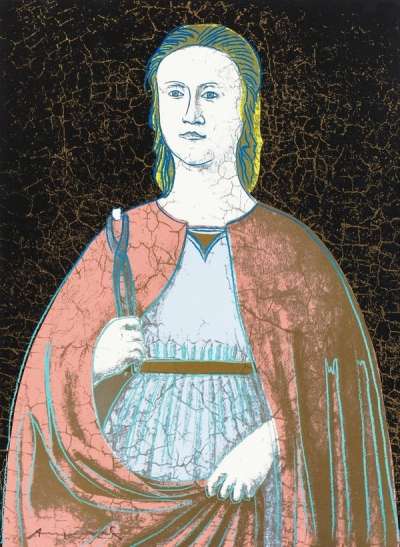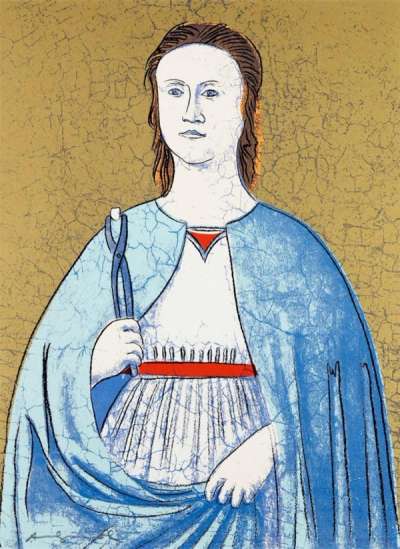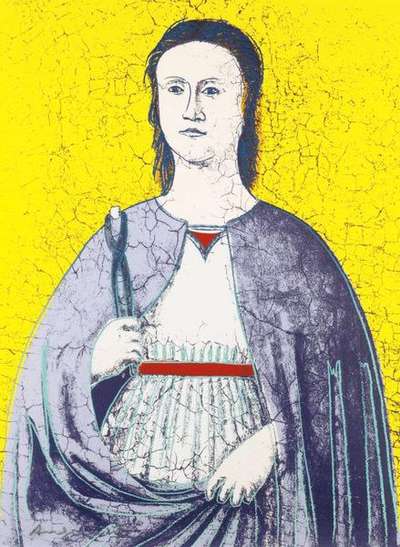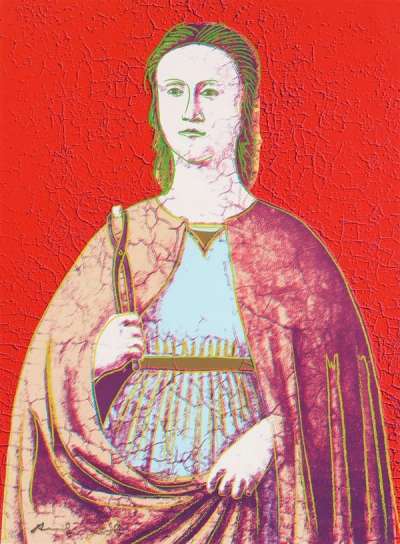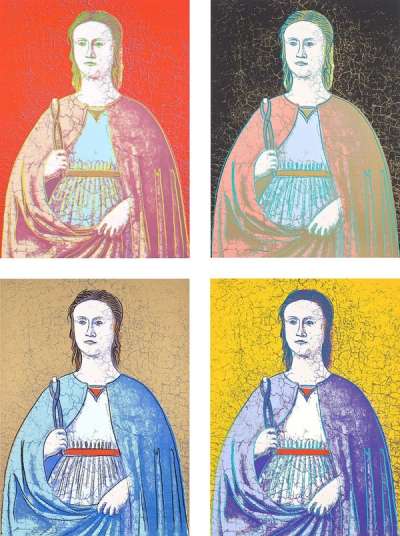Saint
Apollonia
In this series of four screen-prints, Saint Apollonia (1984), Andy Warhol’s Catholic upbringing shines through. Warhol’s subject is martyr and patron saint of dentistry, Saint Apollonia, who it is believed was tortured by having teeth pulled. Hence, Warhol depicts Apollonia holding up a tooth with pliers.
Andy Warhol Saint Apollonia For sale
Saint Apollonia Value (5 Years)
Works from the Saint Apollonia series by Andy Warhol have a strong market value presence, with 118 auction appearances. Top performing works have achieved standout auction results, with peak hammer prices of £68887. Over the past 12 months, average values across the series have ranged from £4983 to £50123. The series shows an average annual growth rate of 15.94%.
Saint Apollonia Market value
Auction Results
| Artwork | Auction Date | Auction House | Return to Seller | Hammer Price | Buyer Paid |
|---|---|---|---|---|---|
 Saint Apollonia (F. & S. II.330) Andy Warhol Signed Print | 26 Oct 2025 | SBI Art Auction | £8,075 | £9,500 | £11,000 |
 Saint Apollonia (complete set) Andy Warhol Signed Print | 22 Oct 2025 | Phillips New York | £22,950 | £27,000 | £40,000 |
 Saint Apollonia (F. & S. II.331) Andy Warhol Signed Print | 19 Sept 2025 | Phillips London | £3,910 | £4,600 | £6,500 |
 Saint Apollonia (F. & S. II.333) Andy Warhol Signed Print | 6 Jun 2024 | Phillips London | £7,225 | £8,500 | £11,500 |
 Saint Apollonia (F. & S. II.332) Andy Warhol Signed Print | 20 Mar 2024 | Sotheby's London | £5,525 | £6,500 | £9,000 |
Sell Your Art
with Us
with Us
Join Our Network of Collectors. Buy, Sell and Track Demand
Meaning & Analysis
In 1984, Andy Warhol produced a series of four screen prints devoted to the martyr and patron saint of dentistry, Saint Apollonia. Each print in the series shows a portrait of Saint Apollonia, a virgin martyr who was tortured by Alexandrian mobs in Egypt in the 2nd century. It is believed that Saint Apollonia was tortured by having her teeth pulled out which is why Warhol depicts Apollonia in this collection of prints holding up a tooth with a pair of pliers.
The prints in this collection are inspired by a portrait of Apollonia which was made by the great Italian painter, Piero della Francesca, in the 15th century. The original painting depicts Apollonia with a sombre expression and sets the martyr against a cracked background which Warhol maintains in his prints. While Warhol often distorts the images that he uses as bases for his prints, the Saint Apollonia collection shows how the artist wanted to create a more authentic representation of the original, iconic painting. Warhol refrains from cropping the image and reproduces the cracks from the original which brings texture to the prints and reminds the viewer of the significant cultural and religious heritage that accompanies this painting of Saint Apollonia. Additionally, instead of using broad brush strokes, layering colours and misaligning shapes to distort the base image, Warhol demonstrates extreme precision in these prints, carefully applying colour and gestural lines to produce an accurate representation of Saint Apollonia.
In each iteration of Saint Apollonia, Warhol sets the Saint against a vibrant block-coloured background. Warhol uses brightly coloured crayon-like lines to delineate her facial features and emphasise the texture of her clothes and the cracked background against which she stands, stoically. Despite Warhol’s use of bold colours, the palette he uses is more muted when compared to his other Pop Art portraits of celebrities which means the original image of Saint Apollonia remains recognisable.
